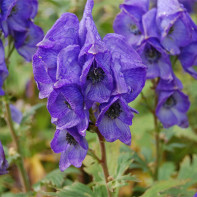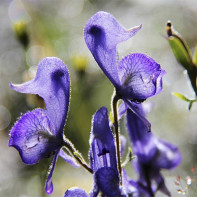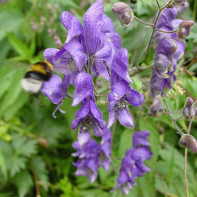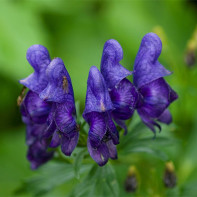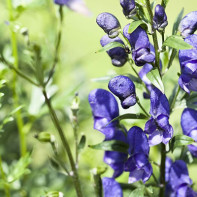Aconite: medicinal properties and contraindications
Aconite (wolfsbane) - herbaceous perennial of the vast Buttercup family. In the CIS countries the plant is known as hellebore, slippertail, blue buttercup, blue-eye, pristrelle. In Russia, Ukraine and Belarus, there are more than three dozen local names for aconite. Aconite has medicinal properties and is used in folk and official medicine.
Chemical Composition
The terrestrial part and roots of aconite contain alkaloids. These substances have an active effect on the human body. In small amounts they have a therapeutic effect, but in large doses they are poisons that are deadly to humans.

The plant contains aconitine. The substance is extremely poisonous and belongs to the neurotoxins. Aconitine varieties (mesoaconitine, benzoaconitine, sasaaconitine, hetaaconitine, benzoylaconin) belong to the first group of alkaloids.
The second group includes sparteine, ephedrine, and napalline. The total content of alkaloids in the tubers and roots of aconite ranges from 0.9 to 4.9%.
The plant material of aconite also includes:
- saponins;
- tannins;
- coumarin;
- Resins and resinous substances;
- various acids (fumaric, citric, benzoic);
- fatty acids (oleic, linoleic, myristic, palmitic, stearic);
- daucosterol;
- inositol;
- mesainodisole;
- Starch and starchy compounds;
- flavonoids;
- sugars.
The raw materials are rich in macronutrients. These are salts of iron and magnesium, potassium and calcium-containing substances. The leaves and roots of the plant contain trace elements - zinc, chromium, barium, selenium, boron, copper, lead and nickel. The stems and leaves contain large amounts of vitamin C.
How it looks and where it grows
Members of the genus vary greatly in appearance, size, shape of leaves and flowers. The size of the plants, the arrangement of the inflorescences and the color of the corollas also vary.
What it looks like
Plants of the genus Aconite have peculiar flowers. They do not resemble the flowers of the classic species of the Buttercup family. The corollas resemble the flowers of the lupine and other members of the legume family.
The large, bright petals are hooded, helmeted, bell-shaped, and calyx-shaped. Most flowers are five-petaled. The upper petal is large, curved, it overhangs the central part of the flower and protects it from accidental damage. The color of the petals is purple, blue, lilac, violet, yellow or white.
Inside the flower hides a corolla converted into 2 honeypots (nectaries) which secrete a sugary, sweet sap that attracts bees and other insects. The flower forms an upper ovary, in which 3 to 7 leaf-fruits mature. They form dozens of small brown seeds.
The leaves of aconites are deep green and bright. They are palmately divided and rounded and cover the stem from bottom to top. The height of the stems depends on the plant species. The lowest representatives of the genus grow to a height of 60 cm, the highest species stretch to 200-220 cm.
The root system of the warthog grows constantly during its life cycle. There are 2 different root systems in different species.
In the first case, it is a tuberous root covered with a black sheath, which grows 1-2 daughter tubers during the summer. They successfully overwinter and give rise to new aconites. The mother tuberous root either dies out or survives the winter with the young nodules. Thus, a chain of several rounded tuberous roots is obtained. Sometimes their number reaches 10-15 pieces. Thin roots depart from the tubers in width and depth.
In the second case, the plant grows numerous, cord-like, long roots. They fuse together to form a flat, strong, slightly twisted tap root.
Where it grows
The range of plants of the genus Aconite extends throughout Europe and North America. These flowers are ubiquitous in the forests of Asia. The wolfberry likes nutritious soils rich in humus and organic acids; it grows in forests and mountain meadows, on moist lake and river shores, in fields and glades, along roads and irrigation canals.
Species
In the Northern Hemisphere there are 330 species of the genus Aconite. On the territory of Russia and the CIS countries 75 species of this plant occur, of which 26 species grow in Siberia, 37 - in the Far East. Widespread species are Altai, white-eared, white-violet, narrow-shelled, Baikal, steppe, thick-leaved, viviparous, Karakol, Dzhungarian, mountain, clobber, buttercup, Sakhalin, rambling. Dozens of representatives of the genus are named after biologists who have studied or discovered rare species.
In 1946, in the Soviet Union, two species of aconite - Dzhungarian wolfberry and Karakol wolfberry - were included in a special list, the State Pharmacopoeia, as medicinal plants. These species are found in the damp forested valleys of the Tien Shan.
There are 4 species of aconite in the middle belt of Russia. Northern knotweed grows throughout the East European Plain, but gravitates to higher latitudes. Woolly-leaved Boretz woolly is distributed up to the Ural mountain range. Aconitum oakland is found only in areas of the Black Earth. Fleurov's borage is a rare plant included in the Red Book.
Gathering and storage
The roots of aconite are harvested from August to October. At this time the tubers have already formed and accumulated nutrients. Procurers dig up both tuberous roots and thin roots. A bayonet shovel is needed for the work. The dug up raw material is washed in clean water and dried. Dry in a ventilated room, under a shed or on a veranda. Raw should not receive sunlight. The drying temperature should not exceed 70 degrees Celsius.
Leaves, stems and flowers are harvested at the height of flowering, in June or July. Greens are cut with a knife or scissors, sorted and dried under a roof in a draught. The drying temperature should not exceed plus 30 degrees.
The plant is extremely poisonous, during harvesting and processing of raw materials should avoid skin contact with sap and root slices. Harvesting should be done with rubber gloves. Trays and racks after drying thoroughly washed with running water.
Store harvested raw materials in tightly sealed glass jars in a dark, cool room. Place storage should not be accessible to children and animals. Shelf life of dry aconite 2 years.
Therapeutic properties of aconite
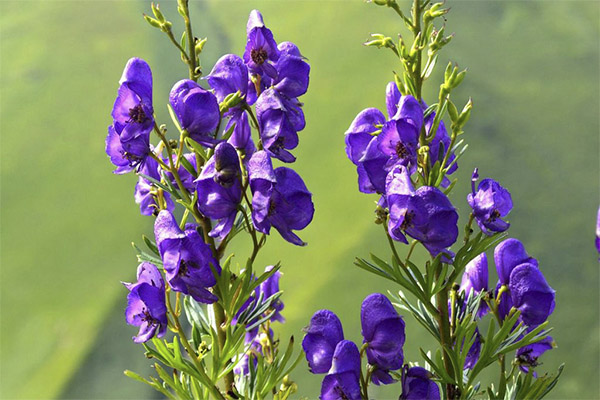
The unique chemical composition of aconite provides a complex effect on the human body. Medical and folk remedies based on the plant have:
- antibacterial;
- antipyretic;
- anti-inflammatory;
- analgesic;
- soothing;
- expectorant;
- antispasmodic;
- astringent;
- styptic;
- diuretic;
- estrogenic effect.
Allapinin tablets, the active ingredient of which is obtained from the roots of white bean hogweed, are prescribed for the treatment of arrhythmia. The drug also has sedative, anesthetic and vasodilator effects.
Other preparations based on aconite, manufactured by pharmacological companies, official medicine recognizes only as external remedies. Alcohol tinctures, ointments, dried root are sold in pharmacies. They are prescribed in the treatment of gout, rheumatism, neurological diseases, radiculitis.
Aconite in traditional medicine
In folk medicine, remedies based on aconite are used to treat dozens of diseases, using them both internally and externally. Recipes of reliable and effective potions are handed down from one generation of healers to another.
In extracts, decoctions and tinctures, the main ingredient of which is borage, folk healers treat tumors (benign and malignant), tuberculosis, cardiovascular pathologies, epilepsy, neurological diseases, including multiple sclerosis, nervous disorders. These preparations take away pain and inflammation in arthritis and arthrosis, sciatica, osteochondrosis, reduce the severity of asthma attacks in adults, and help to recover from lung disease.
Herbalists consider wormwood an effective remedy for migraines, gum inflammation and toothache. Folk healers recommend taking infusions of aconite internally for arrhythmia. Decoctions and tinctures are advised to drink for any heart disorders, weakness of blood vessels.
As an external remedy, preparations based on aconite are used to wash pus-filled, poorly healing wounds and fistulas, treatment of boils, pustular rash. Aqueous infusions treat psoriasis, dermatitis, shingles, horny skin inflammation, neurodermatitis.
Aconite is used to restore blood circulation and reduce muscle pain. Decoctions are rubbed on the scalp to get rid of lice. The infusion cleanses the body from worms and other helminthes. Gargles treat stomatitis, gingivitis, throat infections. Before the advent of antibiotics, solutions infused with aconite treated venereal diseases.
Tincture for toothache and headache
To prepare the remedy you need a bottle of vodka and 20 g of dried aconite root. Fresh raw material is not used in this recipe.
Roots are crushed with a knife and poured into a glass jar, then pour the vodka. The jar is sealed tight lid. The container is placed in a dark place and kept at room temperature for 7-10 days.
The contents of the jar is strained to remove pieces of the root (some authors of recipes recommend leaving the raw material in the alcohol). Ready tincture is stored in a cold place.
For headaches the remedy is used externally. A tablespoon of tincture rubbed (without strong pressure) into the scalp. The procedure is best carried out before bedtime.
To get rid of a toothache, the tincture is rubbed into the skin of the face, in the place where the painful tooth and gums are located. It is not recommended to apply the alcoholic liquid to the mucous membrane of the mouth. Procedures continue until the condition improves, with headaches the course is 1 month, but no more than that.
Decoction for the treatment of purulent skin diseases, boils and washing wounds
To prepare the broth measure 15 g of dried roots aconite and place in an enamel pan (or large mug). Pour a glass of raw material just boiling water, put the vessel on the stove and boil the broth for at least 20 minutes. Then remove from the stove, cover the container with a lid and allow to cool.
Skin, wounds, boils treated with a cotton swab dipped in broth. The procedure is carried out 3-5 times a day.
Tincture for strengthening blood vessels and heart disease treatment
Tincture is prepared from dried roots of aconite and vodka. To prepare the product need 10 g of raw materials and 2 bottles of vodka (1 liter).
The roots are crushed, poured into a liter glass jar and pour vodka. The vessel is tightly closed with a screw or plastic lid, kept in a dark closet for 3-4 days (at room temperature) and filtered. After that, the tincture is ready for use. Vodka can be replaced by medical alcohol 60-70% strength. Store the product in the refrigerator.
Tincture taken three times a day, 2 drops, 30-40 minutes before breakfast, lunch and dinner. Drip it into a glass of water and drink it. The duration of treatment is better to agree with your doctor.
Ointment for the treatment of arthritis
To prepare the product will need 2 teaspoons of crushed flowers aconite and lard (unsalted). Take fresh, freshly blooming flowers.
Flower raw material is placed in a metal enamel bowl. Bacon is melted in a frying pan on low heat and pour it over the flowers.
The pan is placed on the stove, on low heat. Sustain for 15 minutes, constantly stirring the fat. Then the container is moved into the oven, turned on a constant heat of 50-60 degrees. The remedy is kept for 10-12 hours and taken out of the oven.
If there is no electric or gas oven, you can simply wrap the pot and put in a warm place - to the stove or radiator for the same period of time. Ready-made remedy is stored in the refrigerator.
To treat the ointment rubbing motions applied to the joint. A day do 2-3 procedures, the duration of treatment - 7 days. Then make a one-week break and then repeat the course.
Pork fat can be replaced by pharmacy petroleum jelly, which does not contain fragrances and other additives. The technology of preparation of the ointment does not differ from the preparation of a remedy with pig fat.
Alcoholic tincture for the treatment of duodenal ulcer
To prepare the means take 0.6 liters of vodka and 20 g of dried aconite root. Raw material is crushed, pour vodka (or medical alcohol) and kept a week in a darkened place in a living room (closet or cupboard). After that, strain the liquid and cover with an airtight lid.
About the daily and single doses should consult a doctor, because alcohol irritates the mucous membranes. It is important that amateur treatment did not produce side effects.
Oil for joint and muscle pain
To prepare a remedy take 5-7 grams of dried roots aconite and a glass of vegetable oil (folk healers recommend using olive oil). Roots are crushed, placed in a metal enamel bowl and pour hot oil (250 ml.). Place the vessel in a water bath, bring the water to a boil.
Oil is heated for 15 minutes. The remedy cools, poured into a bottle or jar, cover the vessel tightly.
The drug is applied to the joint and sore muscles 2-4 times a day. The oil is rubbed into the skin and make a light massage. The composition is well absorbed and does not irritate the skin.
Tincture for a course of treatment of internal diseases
A teaspoon of dried roots aconite grind, pour a bottle of vodka and insist in a tightly closed container 12-14 days. The place where the drug insists, should be room temperature, not allowed to expose the container to direct sunlight. Vessel daily shaking. After a specified period of time the liquid is strained, the raw material is squeezed and removed.
Course reception begins with 1 drop of the drug, which is added to 50 ml of water. During the day, drink 3 doses of this concentration (in the morning, at lunchtime and in the evening, half an hour before a meal).
Each day add 1 drop, bringing the concentration to 10 drops of tincture for each reception. Then gradually reduce the dose of aconite tincture, counting backwards.
Course duration is 19 days. At the end of the course of treatment a break of 1-1.5 months and repeat the tincture on the same schedule.
Decoction for the treatment of shingles
To prepare the broth will need 6 g of leaves aconite, 40 g of grass succession, 4 cups of water. Raw materials are crushed, mixed, placed in an enamel saucepan and pour boiling water over the plant components. Then place the vessel on the stove, turn on low heat, bring the liquid to a boil and boil for 10-12 minutes. The pan is removed from the stove, cover and cool. The finished broth is strained.
To treat shingles cloth or absorbent cotton soaked in decoction and put on the affected skin. The lotion should be kept for 10 minutes. It is recommended to repeat the procedure twice a day.
Infusion for eczema and psoriasis in a thermos
For preparation, you will need dry herbal raw materials: eucalyptus leaves (30 g) and aconite (3 g). If you have to use fresh plants, pre-dry the leaves, and only then measure on scales the required amount of plant material.
The leaves are crushed and poured into a thermos. Then pour a glass of boiling water over the raw material, close the lid and leave the vessel for 45-50 minutes. After this time, strain the infusion, pour into a large glass jar and diluted with 3 cups of hot boiled water.
To treat eczema and psoriasis make lotions. A cloth or absorbent cotton is soaked in the infusion and put on the affected area for a quarter of an hour. Procedures are performed once a day, the duration of treatment is worth coordinating with a dermatologist.
Complex tincture for the treatment of epilepsy, goiter, neoplasms and polyarthritis
This complex remedy is prepared from the leaves, stems, and flowers of borage collected in June or July. The remedy consists of two parts. Aconite alcohol tincture is prepared separately and a composite herbal tincture with which it is mixed.
To prepare the tincture, take half a cup of dried leaves and flowers of hogweed. Raw materials are well crushed, pour vodka (1.5 liters) and kept 9-10 days in a dark room or a closed cabinet. Then the liquid is filtered and poured into a glass jar for storage.
After "maturation" of the alcohol tincture is prepared the second part of the remedy - herbal infusion. This will need dry raw clover, motherwort, flowers and leaves of celandine, immortelle, mace nettle. We will also need the peppermint herb, meadowsweet, plantain leaves, chicory flowers, sage leaf, heather, matured hop cones.
Measure an equal amount of all the ingredients and thoroughly grind the herbs (almost into flour). Then prepare the infusion. A teaspoon of grass meal (no topping) brewed with a glass of boiling water, cover the vessel with a lid and incubated for 7-8 hours.
Take a remedy as follows. A glass poured 50-70 ml of herbal infusion and add 5 drops of alcohol aconite tincture. Drink the drug three times a day, 30-40 minutes before a meal.
Such a dosage (5 drops per reception) incurred for 5 days. Then every five days increase the concentration of aconite tincture for 5 drops, bringing a single dose of 50 drops.
About the cancellation of the remedy should consult a doctor, because some folk healers allow abrupt cessation of treatment, others believe that the withdrawal should be smooth. Herbal infusion is not stored for more than a day and is brewed daily.
Types of healing compositions
From the dried roots and the ground part of aconite prepare infusions and tinctures, medicinal oils and ointments. The amount of raw materials in different recipes can vary significantly. But the general principles of preparing folk remedies are the same.
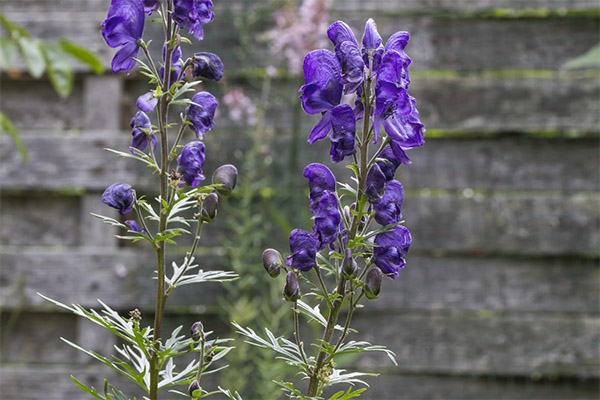
Infusion
Infusions of aconite are prepared as a tea, brewing crushed dry raw material with boiling water and infusing it until it cools. Freshly picked leaves and flowers are first dried to avoid overdosing (almost all available recipes include only dried material).
If heating is mentioned in the preparation procedure, it is done in a water bath. But there are quite a few recipes that specify simple boiling on the stove. If boiling takes more than 5 minutes, we should talk about preparing a decoction, not an infusion.
Tincture
When making aconite tincture, take high-quality vodka or medical alcohol with a strength of up to 70 degrees. It can be diluted with boiled water to 40 degrees.
Dry raw material is measured with a spoon (or kitchen scale), poured into a glass jar and pour the alcohol (vodka). Then hermetically sealed vessel.
Sunlight destroys the useful substances coming from the raw material in the liquid, so the tincture is put in a dark place. The remedy is kept for a given time at a temperature of 15 to 24 degrees, after which the jar is opened and the contents is strained. The tincture is ready, it can be used for several months.
Oil
Aconite oil is prepared on the basis of olive or sunflower fat component, dried root and the green part of the plant. For preparation, use a small enameled pot or a mug.
Measure the required amount of dried aconite, put it in the container and pour the oil. To get the maximum yield of useful substances, the vessel with the ingredients is placed in a boiling water bath and incubated for the time specified in the recipe. After that, the remedy is cooled and used as directed.
Ointment
Ointments are made on the basis of petroleum jelly or pork fat (which is pre-cooked on low heat). As aconite raw material take dried root and leaves or freshly picked flowers and leaves.
The ingredients are weighed, measured, and combined in a metal enamel bowl. The vessel is placed in a water bath so that the fat component becomes liquid, and heated with constant stirring over low heat.
Then the vessel is removed from the bath, cover, wrap with a towel and put in a warm place for 10-12 hours. During this time the plant raw material will evaporate and release useful substances in the fat base. You can put a container in the oven, heated to a temperature of 50-60 degrees (for the same time). After cooling, the drug is used for therapeutic procedures.
Contraindications to use
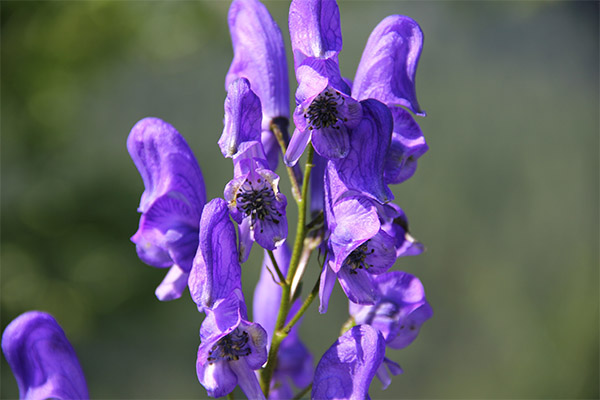
Poisonous alkaloids contained in the plant impose a number of restrictions on the use of drugs. Contraindications to the prescription are:
- pregnancy;
- breastfeeding;
- alcohol and drug dependence;
- Hypertension and hypotension;
- renal insufficiency;
- liver disease;
- allergic reaction to substances contained in plant raw materials and extracts;
- Acute infectious diseases.
Drugs, which includes wolfberry, is not prescribed for children and adolescents.
When accidental use of dried raw materials, freshly cut leaves and flowers of wolfberry, an overdose of pharmacy and folk remedies should immediately call an ambulance. The plant is highly poisonous, in the absence of professional medical care poisoning can be fatal. Before the arrival of doctors should drink large quantities of water with activated charcoal and induce vomiting.
Healers consider onions and sour milk an antidote. But these remedies will help only if the poisoning is mild. Herbalists also recommend to drink an infusion of the poisonous aconitum infusion antipoisonous.
«Important: All information on this site is provided for informational purposes only purposes. Consult with your health care professional before applying any recommendations. specialist before using the recommendations. Neither the editors nor the authors shall be liable for any possible harm caused by materials."

